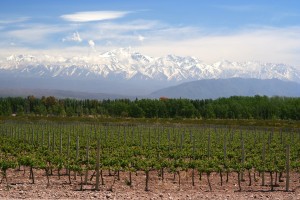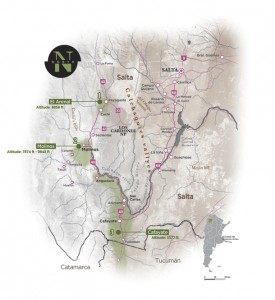 The Salta wine region, in the far north of Argentina, is a wine region of extremes. Starting at around 24°S latitude, the area is the same distance from the equator as Baja California, Key West, and Riyadh. Viticulture in this low latitude is made possible by another extreme, as Salta is home to the highest altitude vineyards in the world.
The Salta wine region, in the far north of Argentina, is a wine region of extremes. Starting at around 24°S latitude, the area is the same distance from the equator as Baja California, Key West, and Riyadh. Viticulture in this low latitude is made possible by another extreme, as Salta is home to the highest altitude vineyards in the world.
Interestingly enough, these two extremes seem to work well together, as the heat that would be expected from the low latitude is balanced by the cool temperatures expected in high altitudes. The combination makes this region uniquely well suited for producing quality wine. The rain shadow of the Andes keeps the region dry while providing meltwater from the snowy peaks for irrigation. The diurnal temperature swing here is also extreme; in the summer, day time temperatures can soar up to 100°F and down to 55°F that same night. This wide fluctuation allows the grapes to gain sugar ripeness in the day, while holding onto is acidity at night.
Salta currently has less than 5,000 acres under vine, and accordingly produces just a tiny percentage of Argentina’s wine; however, the region has an excellent reputation for high quality. Two of Salta’s subregions—Cafayate and Molinos—are particularly well-known for their high-altitude vineyards.
 Cafayate: The largest subregion, Cafayate, is home to over 70% of the vineyards in Salta. The vineyards here range in altitude from 5,000 to 7,000 feet above sea level. Cafayate is well-known for high-quality Torrontés as well as Malbec, and is beginning to be planted to Chardonnay, Tannat, and Cabernet Sauvignon. Cafayate is located within the scenic Colcchaquí Valley (Valles Calchaquíes), a tourist region well-known for its diverse colors, scenic beauty, and wide range of terrain from high mountain dessert to sub-tropical forests.
Cafayate: The largest subregion, Cafayate, is home to over 70% of the vineyards in Salta. The vineyards here range in altitude from 5,000 to 7,000 feet above sea level. Cafayate is well-known for high-quality Torrontés as well as Malbec, and is beginning to be planted to Chardonnay, Tannat, and Cabernet Sauvignon. Cafayate is located within the scenic Colcchaquí Valley (Valles Calchaquíes), a tourist region well-known for its diverse colors, scenic beauty, and wide range of terrain from high mountain dessert to sub-tropical forests.
Molinos: Starting at an altitude of 7,000 feet and climbing, the region of Molinos surrounds the town of the same name. It is here that you will find the highest altitude vineyards in the world. Pre-phylloxera Malbec and Cabernet Sauvignon were brought here from France in 1854 and some of these vines still thrive.
Bodega Colomé, one of the oldest wineries in Argentina, was founded here in 1831. After searching for years for the perfect spot to produce Argentine wine, Donald and Ursula Hess of the Hess Collection purchased the property in 2001.
 Bodega Colomé has four vineyards, all of them fairly close to the sun. The La Brava Vineyard, located in Cafayate, sits at 5,741 feet. The Colomé Vineyard, surrounding the winery in Molinos, begins at 7,545 feet. The El Arenal vineyard, a relatively young vineyard planted to Malbec, begins at an elevation of 8,858 feet. One of the highest vineyards in the world, Altura Maxima, is here in the Molinos subregion; it sits at an altitude of 10,206 feet.
Bodega Colomé has four vineyards, all of them fairly close to the sun. The La Brava Vineyard, located in Cafayate, sits at 5,741 feet. The Colomé Vineyard, surrounding the winery in Molinos, begins at 7,545 feet. The El Arenal vineyard, a relatively young vineyard planted to Malbec, begins at an elevation of 8,858 feet. One of the highest vineyards in the world, Altura Maxima, is here in the Molinos subregion; it sits at an altitude of 10,206 feet.
The winery’s flagship wine, Colomé Reserva Malbec, is produced from the oldest pre-phylloxera vines on the estate. These vines range from 60 to 150 years old.
If you think you can handle the high altitude, Bodega Colomé welcomes guests to its vineyards at the top of the world, complete with a visitor center, world-class restaurant and art gallery.
References/for further learning:
- Bodega Colomé: http://www.bodegacolome.com/
- Map of Salta via Wines of Argentina: http://winesofargentina.org/en
To be fair: Bolivia also claims to have the highest vineyards in the world…rest assured we will investigate soon!